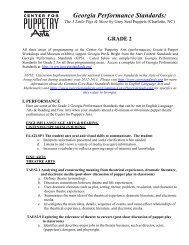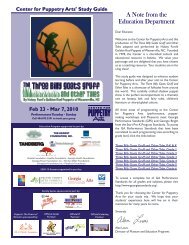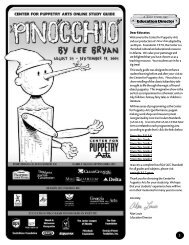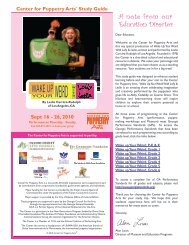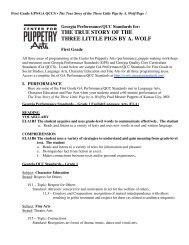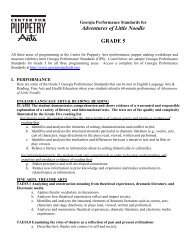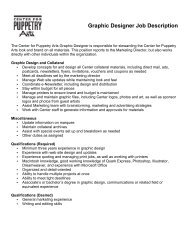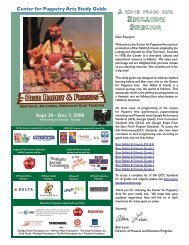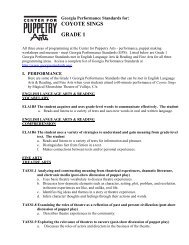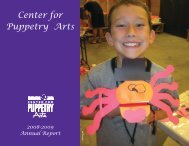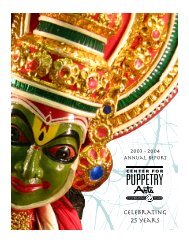The Headless Horseman of Sleepy Silly Hollow - Center for ...
The Headless Horseman of Sleepy Silly Hollow - Center for ...
The Headless Horseman of Sleepy Silly Hollow - Center for ...
Create successful ePaper yourself
Turn your PDF publications into a flip-book with our unique Google optimized e-Paper software.
<strong>Center</strong> <strong>for</strong> Puppetry Arts ®<br />
Educator Resource Guide<br />
By Frogtown Mountain Puppeteers<br />
<strong>of</strong> Bar Harbor, ME<br />
Oct 24 - Nov 4, 2012<br />
Per<strong>for</strong>mances Wednesday - Sunday<br />
Call 404.873.3391 to book your group<br />
<strong>The</strong> <strong>Center</strong> <strong>for</strong> Puppetry Arts is supported in part by:<br />
<strong>Center</strong> <strong>for</strong> Puppetry Arts is a non-pr<strong>of</strong>it, 501(c)(3) organization and is supported in part<br />
by contributions from corporations, foundations, government agencies, and individuals.<br />
Major funding <strong>for</strong> the <strong>Center</strong> is provided by the Fulton County Board <strong>of</strong><br />
Commissioners under the guidance <strong>of</strong> the Fulton County Arts Council.<br />
<strong>The</strong>se programs are supported in part by the Georgia Council <strong>for</strong> the Arts<br />
through the appropriations from the Georgia General Assembly.<br />
GCA is a Partner Agency <strong>of</strong> the National Endowment <strong>for</strong> the Arts.<br />
Major support is provided by the City <strong>of</strong> Atlanta Office <strong>of</strong> Cultural Affairs.<br />
<strong>The</strong> <strong>Center</strong> is a Member <strong>of</strong> <strong>The</strong>atre Communications Group.<br />
<strong>The</strong> <strong>Center</strong> also serves as headquarters <strong>of</strong> UNIMA-USA, the American branch <strong>of</strong><br />
Union Internationale de la Marionnette, the international puppetry organization.<br />
© 2012 <strong>Center</strong> <strong>for</strong> Puppetry Arts ®<br />
Photo courtesy <strong>of</strong> Frogtown Mountain Puppeteers<br />
®<br />
A note from our<br />
Education Department<br />
Dear Educator/Parent,<br />
Welcome to the <strong>Center</strong> <strong>for</strong> Puppetry Arts and this<br />
production <strong>of</strong> <strong>The</strong> <strong>Headless</strong> <strong>Horseman</strong> <strong>of</strong> <strong>Silly</strong> <strong>Sleepy</strong><br />
<strong>Hollow</strong> by Frogtown Mountain Puppeteers <strong>of</strong> Bar<br />
Harbor, Maine. We’re delighted you’re joining us <strong>for</strong><br />
this live puppet theatre experience!<br />
<strong>The</strong> <strong>Headless</strong> <strong>Horseman</strong> <strong>of</strong> <strong>Silly</strong> <strong>Sleepy</strong> <strong>Hollow</strong> is a<br />
delightful retelling <strong>of</strong> the classic Washington Irving<br />
tale, per<strong>for</strong>med by a trio <strong>of</strong> puppeteer siblings from<br />
the New England area <strong>of</strong> the Unites States. This fastpaced,<br />
comedic show is the perfect accompaniment to<br />
a thematic unit on folk tales, autumn holidays, horses,<br />
the harvest, and rural American history – and is a great<br />
example <strong>of</strong> visual, musical, and dramatic arts.<br />
It has been proven (through test scores and numerous<br />
studies) that the arts<br />
• invite empathy and interaction<br />
• stretch the imagination<br />
• develop important coordination and language skills<br />
(emotional and spoken)<br />
• satisfy educational objectives across the curriculum<br />
• support literacy and writing<br />
• enhance social skills such as problem solving, turntaking<br />
and active listening<br />
• impact attendance in a positive way<br />
• improve motivation and behavior<br />
• and simply allow children to have fun (they’re<br />
called “plays” <strong>for</strong> a reason, after all!)<br />
This Educational Companion can be used to enhance<br />
the educational opportunities provided by this<br />
show. Though an excellent way to prepare <strong>for</strong> the<br />
experience <strong>of</strong> seeing a live puppet theatre production,<br />
this in<strong>for</strong>mation can also be used as a springboard <strong>for</strong><br />
follow-up fun after the curtain has gone down. This<br />
per<strong>for</strong>mance supports educational standards across<br />
the curriculum, and is a great deal fun, too!<br />
To access the Georgia Per<strong>for</strong>mance standards <strong>for</strong> this<br />
show that correlate to each programming area at the<br />
<strong>Center</strong> (per<strong>for</strong>mance, Create-A-Puppet Workshop,<br />
and Museum exhibits) click the links below:<br />
<strong>The</strong> <strong>Headless</strong> <strong>Horseman</strong> <strong>of</strong> <strong>Silly</strong> <strong>Hollow</strong>, P-K & K<br />
<strong>The</strong> <strong>Headless</strong> <strong>Horseman</strong> <strong>of</strong> <strong>Silly</strong> <strong>Hollow</strong>, Grade 1<br />
<strong>The</strong> <strong>Headless</strong> <strong>Horseman</strong> <strong>of</strong> <strong>Silly</strong> <strong>Hollow</strong>, Grade 2<br />
<strong>The</strong> <strong>Headless</strong> <strong>Horseman</strong> <strong>of</strong> <strong>Silly</strong> <strong>Hollow</strong>, Grade 3<br />
<strong>The</strong> <strong>Headless</strong> <strong>Horseman</strong> <strong>of</strong> <strong>Silly</strong> <strong>Hollow</strong>, Grade 4<br />
<strong>The</strong> <strong>Headless</strong> <strong>Horseman</strong> <strong>of</strong> <strong>Silly</strong> <strong>Hollow</strong>, Grade 5<br />
<strong>The</strong> <strong>Headless</strong> <strong>Horseman</strong> <strong>of</strong> <strong>Silly</strong> <strong>Hollow</strong>, Grade 6<br />
To access a complete list <strong>of</strong> standards <strong>for</strong> all grades<br />
and subjects, please visit http://www.georgiastandards.<br />
org/.<br />
NOTE: Classroom Implementation <strong>for</strong> the national Common<br />
Core standards in the state <strong>of</strong> Georgia is being rolled out<br />
during academic year 2012-2013. Please visit http://www.<br />
corestandards.org <strong>for</strong> more in<strong>for</strong>mation about the Common<br />
Core State Standards Initiative in English Language Arts<br />
and Mathematics and https://www.georgiastandards.org/<br />
Common-Core/Pages/default.aspx <strong>for</strong> specifics as they relate<br />
to Georgia.<br />
Thanks <strong>for</strong> being with us. Enjoy the show!<br />
Sincerely,<br />
Aretta Baumgartner, Education Director
NOTE: A very special “thank you” to Robin Torbek-Erlandsen and the Frogtown Mountain Puppeteers<br />
<strong>for</strong> their assistance with this Educator Resource Guide.<br />
Select activities are reprinted with their encouragement and permission.<br />
PRE-SHOW ACTIVITIES / DISCUSSIONS<br />
WHAT IS A PUPPET?<br />
A “puppet” is an inanimate (non-living) object that is brought to life by an outside <strong>for</strong>ce (usually a human being working as<br />
a per<strong>for</strong>mer) in order to tell a story.<br />
<strong>The</strong> <strong>Headless</strong> <strong>Horseman</strong> <strong>of</strong> <strong>Silly</strong> <strong>Sleepy</strong> <strong>Hollow</strong> showcases one particular style <strong>of</strong> puppetry: mouth and rod puppets (or moving<br />
mouth puppets). This is sometimes called “Muppet-style puppetry,” too, as this style was made popular by Jim Henson and<br />
his Muppets. <strong>The</strong>re are twenty (20) hand-in-mouth and rod puppets in this show, all made in Frogtown Mountain’s puppet<br />
studio in Bar Harbor. <strong>The</strong> puppets are made from felt, fleece, and other s<strong>of</strong>t fabrics. Frogtown’s puppet builders sketch a<br />
design <strong>of</strong> the character, translate the sketch into a pattern <strong>for</strong>m, trace it onto material, and sew the pieces together on a<br />
sewing machine. <strong>The</strong>n features (eyes, nose, hair, etc.) are added using a hot-glue gun. Ping-pong, wooden, or styr<strong>of</strong>oam balls<br />
are used <strong>for</strong> eyes, with paint markers creating the iris and pupil <strong>of</strong> the eyes. More felt can be used <strong>for</strong> ears and noses, sometimes<br />
with cardboard underneath to help add shape. Yarn or wigs is/are used <strong>for</strong> hair, and the puppets are usually costumed<br />
in baby or toddler clothes that are purchased at thrift stores. Metal rods (insulation rods from the hardware store) are<br />
attached to their hands so that the puppeteers can control their arm and hand movements.<br />
<strong>The</strong>re are also some shadow puppets used in <strong>The</strong> <strong>Headless</strong> <strong>Horseman</strong> <strong>of</strong> <strong>Silly</strong> <strong>Sleepy</strong> <strong>Hollow</strong>. People all around the world have<br />
been using shadow puppetry to tell stories <strong>for</strong> many centuries. Shadow puppets are cutout figures held between a source<br />
<strong>of</strong> light and a translucent screen. In this show, red and yellow light bulbs are used <strong>for</strong> the source <strong>of</strong> light, and a sky-colored<br />
bed sheet is used <strong>for</strong> the translucent shadow screen. <strong>The</strong> actual shadow puppet is not seen by the audience, just the shadow<br />
it creates. Frogtown makes their shadow puppets out <strong>of</strong> either cardboard or stiff paperboard. First they cut out the shape<br />
<strong>of</strong> the puppet, then they attach stiff wires or rods that are used to manipulate the puppet. Sometimes they use brass metal<br />
fasteners to give the shadow puppet moving parts.<br />
• DISCUSSION: Ask the children what puppets are. Have they seen them be<strong>for</strong>e? Are they real or pretend?<br />
What can be used as a puppet? Out <strong>of</strong> what materials can puppets be made, and why would you choose some<br />
materials over others <strong>for</strong> certain projects? Have you ever made your own mouth puppets or shadow puppets?<br />
WHAT IS A PUPPETEER?<br />
A per<strong>for</strong>mer who uses a puppet or puppets to tell a story is called a “puppeteer.”<br />
<strong>The</strong>re are three puppeteers in <strong>The</strong> <strong>Headless</strong> <strong>Horseman</strong> <strong>of</strong> <strong>Silly</strong> <strong>Sleepy</strong> <strong>Hollow</strong>: Brian Torbek, Erik Torbek, and Robin Torbek-<br />
Erlandsen. <strong>The</strong>y are siblings (two brothers and one sister) and have toured and per<strong>for</strong>med together since the year 2000.<br />
• DISCUSSION: What skills does it take to be a puppeteer? What are some challenges that the Torbeks might<br />
face as brothers and a sister traveling together, living together and working together? What things would<br />
be easier <strong>for</strong> them as they work and travel because they know each other so well? Ask your students about<br />
the things that they have in common with their siblings (or other family members) that could lead to working<br />
together or creating together.<br />
© 2012 <strong>Center</strong> <strong>for</strong> Puppetry Arts ® . All Rights Reserved.<br />
2
WHAT IS AN AUDIENCE?<br />
Being a good audience member is as important as being a good puppeteer! It takes teamwork between audience and<br />
puppeteer/actor to make a show successful. <strong>The</strong>re are “rules <strong>of</strong> etiquette” that need to be employed, such as:<br />
• A LIVE SHOW IS DIFFERENT THAN TV OR MOVIES. It’s okay to have fun, but do remember that the<br />
people on-stage (and in the audience) can hear you—be polite!<br />
• MAKE SURE EVERYONE CAN SEE. Stay seated so the audience members behind you can see the show.<br />
• BE SUPPORTIVE. <strong>The</strong> way audience members show they like something is to applaud. Make sure to<br />
applaud if you appreciate what you see and hear. Between songs or scenes, after the show, and after the<br />
post-show demonstration are appropriate places/times to show your appreciation.<br />
• LISTEN CLOSELY. It’s important that you hear all the details <strong>of</strong> the story so that you can enjoy it fully.<br />
• DISCUSSION: Review the “rules” <strong>of</strong> being a good audience member. Role play what is appropriate and<br />
what is not.<br />
WHAT IS THE STORY WE’LL SHARE (THE STORY SYNOPSIS)?<br />
<strong>The</strong> <strong>Headless</strong> <strong>Horseman</strong> <strong>of</strong> <strong>Silly</strong> <strong>Sleepy</strong> <strong>Hollow</strong> puppet show is a comedic version <strong>of</strong> the classic Washington Irving tale, “<strong>The</strong> Legend<br />
<strong>of</strong> <strong>Sleepy</strong> <strong>Hollow</strong>.” Based loosely on the original story, this re-telling involves a bumbling <strong>Headless</strong> <strong>Horseman</strong>, his wisecracking<br />
horse, the meat-head Brom Bones, the lovely Katrina Van Tassel, her ostentatiously rich father, and the mild-mannered and<br />
lovable protagonist, Ichabod Crane. Ichabod befriends the hapless, headless ghoul, and advises him in his search <strong>for</strong> a suitable<br />
replacement head. Meanwhile, a jealous Brom Bones tries to run Ichabod out <strong>of</strong> town while they both vie <strong>for</strong> the affections <strong>of</strong><br />
Katrina. In the end, the <strong>Horseman</strong> saves the day and everyone ends up happily ever after.<br />
• DISCUSSION: Read the story out loud to the class using one <strong>of</strong> these online versions:<br />
http://tlc.howstuffworks.com/family/ghost-stories2.htm (<strong>for</strong> grades preK-3)<br />
http://www.planetebook.com/<strong>The</strong>-Legend-<strong>of</strong>-<strong>Sleepy</strong>-<strong>Hollow</strong>.asp (<strong>for</strong> grades 4-6)<br />
WHO CREATED THE PUPPET SHOW?<br />
Frogtown Mountain Puppeteers is a puppetry troupe based in Bar Harbor, Maine; comprised <strong>of</strong> three siblings Erik Torbeck,<br />
Brian Torbeck, and Robin Torbek-Erlandsen. Founded in 2000, Frogtown Mountain Puppeteers has per<strong>for</strong>med all over the<br />
United States at festivals, schools, libraries, and theaters. <strong>The</strong>ir production <strong>of</strong> <strong>The</strong> <strong>Headless</strong> <strong>Horseman</strong> <strong>of</strong> <strong>Sleepy</strong> <strong>Hollow</strong> has<br />
been presented at the Puppeteers <strong>of</strong> America Regional Festival in Maryland, the Puppet Showplace <strong>The</strong>atre in Brookline,<br />
Massachusetts, and Puppets Up International Festival <strong>of</strong> Puppets in Ontario, Canada.<br />
• DISCUSSION: Visit the website <strong>of</strong> the Frogtown Mountain Puppeteers. View photos from the show in the<br />
“Photo Gallery” and discuss which characters you think are represented in the photos. What impressions <strong>of</strong> their<br />
personalities do you get from the images? http://frogtownpuppets.com<br />
Frogtown Mountain<br />
Puppeteers with<br />
puppets from some<br />
<strong>of</strong> their shows<br />
3
Learning Activities<br />
Learning Activity, P-K & K: How do pumpkins grow?<br />
Georgia Bright from the Start Pre-K Content Standards covered: Language and Literacy Development LD1d,<br />
LD1f, LD3a, LD5k; Scientific Development SD1f, SD2d<br />
Georgia Per<strong>for</strong>mance Standards covered, Kindergarten: English Language Arts and Reading ELAKR1, ELAKR4,<br />
ELAKR6, ELAKLSV1; Characteristics <strong>of</strong> Science SKCS4, SKL2<br />
Objective: Students will understand the life cycle <strong>of</strong> a pumpkin and practice sequencing.<br />
Materials: sentence strips, display board, sequence drawing sheets (one per student), crayons<br />
Procedure:<br />
1. Prepare sentence strips with the following statements:<br />
Plant the seeds.<br />
A vine begins to grow.<br />
Green leaves <strong>for</strong>m on the vine.<br />
Pumpkin flowers grow on the vine.<br />
A little green pumpkin starts to grow.<br />
<strong>The</strong> pumpkin grows and turns orange.<br />
Time to pick the pumpkin.<br />
2. Read the sentence strips aloud to the students in sequential order. Have them repeat each sentence after it is<br />
read.<br />
3. Rearrange the sentences so that they are out <strong>of</strong> sequential order. Ask students to help you put them back in the<br />
correct order, and post them in that correct sequential order on the display board.<br />
4. Have students draw a picture <strong>of</strong> each <strong>of</strong> the steps <strong>of</strong> the sequence on their sequence drawing sheet. Provide<br />
assistance as/if necessary rein<strong>for</strong>cing the steps <strong>of</strong> the sequence.<br />
Assessment: Meet with students one-on-one and confirm that their pictures match the sequences. Remediate if<br />
necessary.<br />
4
Sequence drawing sheet<br />
Sequence Drawing Sheet<br />
© 2012 <strong>Center</strong> <strong>for</strong> Puppetry Arts ® . All Rights Reserved.<br />
5
Learning Activity, 1st & 2nd Grade: Enjoy a pumpkin float!<br />
Georgia Per<strong>for</strong>mance Standards covered, Grade 1: Mathematics (Number and Operations) M1N3, M1M1, M1G2,<br />
M1D1<br />
Georgia Per<strong>for</strong>mance Standards covered, Grade 2, Mathematics (Number and Operations) M2N1, M2N2, M2D1<br />
Objective: Students will use graphing to predict floatability <strong>of</strong> pumpkins (and/or other vegetables) and will learn the<br />
definition <strong>of</strong> “density.”<br />
Materials: chart paper and marker (or chalk board, dry erase board or SMART Board), pumpkin cutouts, crayons,<br />
scissors, tape, sand pail (or bucket), trash bag or drop cloth, water, small pumpkin (and/or other vegetables)<br />
Procedure:<br />
1. Set up a trash bag/drop cloth, and place on it a bucket half-filled with water. Place pumpkin nearby.<br />
2. Xerox one pumpkin cutout per student (example on the bottom on this page).<br />
3. Label a chart page (or chalk board, dry erase board or SMART Board) with the question “Do pumpkins float?”.<br />
Make a column <strong>for</strong> “yes” (yes, pumpkins DO float!) and a column <strong>for</strong> “no” (no, pumpkins DON’T float).<br />
4. Distribute pumpkin cutouts and crayons. Have children color (and carefully cut out, if applicable) one pumpkin<br />
each.<br />
5. Ask students to predict whether or not the pumpkin will float, and have them tape up their pumpkin in the<br />
appropriate column on the chart. Discuss why the choices were made, and count the number <strong>of</strong> students who<br />
predicted “yes” and predicted “no.” Discuss the terms “majority” and “minority” (and how these terms are<br />
related to the more-familiar terms “more”/“greater than” and “less”/“less than”).<br />
6. Place pumpkin in water and watch results. Discuss that it’s DENSITY, not WEIGHT, that determines floatability<br />
<strong>of</strong> objects. DENISTY = how weight is distributed across an item.<br />
7. VARIATIONS: This activity can be done in small groups and/or with other vegetables. It can also be done with a<br />
series <strong>of</strong> pumpkins and buckets, ranging from small pumpkins/buckets to large pumpkins/buckets.<br />
Assessment: Quiz students on the terms “density,” “majority” and “minority” after a few weeks have passed to see if<br />
they have retained the in<strong>for</strong>mation.<br />
Pumpkin cutout<br />
6
Learning Activity, 3rd & 4th: Mapping <strong>Sleepy</strong> <strong>Hollow</strong><br />
Georgia Per<strong>for</strong>mance Standards covered, Grade 3: English and Language Arts (Reading and Writing) ELA3R3,<br />
ELA3W2<br />
Georgia Per<strong>for</strong>mance Standards covered, Grade 4: English and Language Arts (Reading and Writing) ELA4R1,<br />
ELA4W2<br />
Objective: Students will create story maps and character maps in order to better understand the structure <strong>of</strong> an<br />
effective story and the creation <strong>of</strong> strong characters within that story.<br />
Materials: paper and pencil <strong>for</strong> each student, chart paper and marker (or chalk board, dry erase board or SMART<br />
Board), and synopsis <strong>of</strong> story (see page 3 <strong>of</strong> this Guide <strong>for</strong> a short synopsis and links to in-depth synopsis)<br />
Procedure, Story Map:<br />
1. Label chart paper (or chalk board, dry erase board or SMART Board) with the terms<br />
-beginning<br />
-topic<br />
-characters<br />
-setting<br />
Leave space after/between each word <strong>for</strong> answers. Have students do the same on their own paper.<br />
2. Discuss these terms with the students. Have students discuss and identify the beginning <strong>of</strong> the story in one<br />
sentence, and write this down. Discuss and identify what the topic (main idea) <strong>of</strong> the story is and write this down.<br />
Do the same <strong>for</strong> characters and setting.<br />
3. Label your display board with the terms<br />
-middle<br />
-event 1<br />
-event 2<br />
-event 3<br />
(and other events as identified/necessary)<br />
4. Discuss these terms with the students. Have students discuss and identify the middle <strong>of</strong> the story in one<br />
sentence, and write this down. Discuss and identify what the events <strong>of</strong> the story are and write them down.<br />
5. Label your display board with the terms<br />
-climax<br />
-conclusion<br />
6. Discuss these terms with the students. Have students discuss and identify the climax <strong>of</strong> the story in one<br />
sentence, and write this down. Discuss and identify what the conclusion <strong>of</strong> the story is and write this down.<br />
7. Review with the students, having students take turns reading their work out loud.<br />
© 2012 <strong>Center</strong> <strong>for</strong> Puppetry Arts ® . All Rights Reserved. 7
Procedure, Character Map:<br />
1. Label chart paper (or chalk board, dry erase board or SMART Board) with the terms<br />
-character’s name<br />
-character’s actions<br />
-character’s emotions<br />
-character’s dialogue<br />
Leave space after/between each word <strong>for</strong> answers. Have students do the same on their own paper.<br />
2. Discuss these terms with the students. Have students discuss and identify the character elements <strong>for</strong> each <strong>of</strong> the<br />
story’s main characters: the <strong>Headless</strong> <strong>Horseman</strong>, the <strong>Headless</strong> <strong>Horseman</strong>’s Horse, Brom Bones, Katrina Van Tassel,<br />
Katrina’s father, and Ichabod Crane.<br />
3. Review with the students, having students take turns reading their work out loud.<br />
VARIATIONS AND ADDITIONAL APPLICATIONS:<br />
*If this activity is done be<strong>for</strong>e the show, revisit your work after the show and compare the version <strong>of</strong> the story you saw<br />
with the version <strong>of</strong> the story you read be<strong>for</strong>e attending the show.<br />
*Have students draw pictures <strong>of</strong> the story map—this is called a “story board” and is used when puppet shows are<br />
created. Story boards are used to cement visual images <strong>of</strong> the important parts <strong>of</strong> the show and are especially useful<br />
to scriptwriters and to set/scenic designers.<br />
*Have students draw pictures <strong>of</strong> the characters—these are called “character sketches” and are used when creating<br />
puppet designs.<br />
Assessment: Quiz students on the terms used in this activity after a few weeks have passed to see if they have<br />
retained the in<strong>for</strong>mation. Apply these same techniques to other stories shared in class.<br />
8
Learning Activity, 5th & 6th: Mapping your own tale!<br />
Georgia Per<strong>for</strong>mance Standards covered, Grade 5: English and Language Arts (Reading and Writing) ELA5R1,<br />
ELA5W2<br />
Georgia Per<strong>for</strong>mance Standards covered, Grade 6: English and Language Arts (Reading and Writing) ELA6R1,<br />
ELA6W1, ELA6W2<br />
Objective: Students will create story maps and character maps in order to better understand the structure <strong>of</strong> an<br />
effective story and the creation <strong>of</strong> strong characters within that story. After a review <strong>of</strong> some different genres <strong>of</strong><br />
literature, students will create their own story in the genre <strong>of</strong> their choice following the conventions/elements <strong>of</strong><br />
effective writing (as displayed through the use <strong>of</strong> story and character mapping).<br />
Materials: paper and pencil <strong>for</strong> each student, chart paper and marker (or chalk board, dry erase board or SMART<br />
Board), synopsis <strong>of</strong> story (see page 3 <strong>of</strong> this Guide <strong>for</strong> a short synopsis and links to in-depth synopsis), “Mapping <strong>Sleepy</strong><br />
<strong>Hollow</strong>” activity from pages 7 and 8 <strong>of</strong> this Guide<br />
Procedure:<br />
1. Have students complete the “Mapping <strong>Sleepy</strong> <strong>Hollow</strong>” activity (pages 7 and 8 <strong>of</strong> this Guide).<br />
2. Review familiar genres <strong>of</strong> literature with the students:<br />
FOLKTALE - A story or legend <strong>for</strong>ming part <strong>of</strong> an oral tradition.<br />
LEGEND - A traditional tale handed down from earlier times and believed to have an historical basis.<br />
FABLE - A short narrative making a moral point. Often employs animals with human characteristics (powers<br />
<strong>of</strong> speech, etc.) as the main characters <strong>of</strong> the story.<br />
FAIRY TALE - A fanciful tale <strong>of</strong> legendary deeds and creatures, usually intended <strong>for</strong> children.<br />
TALL TALE - An extravagant, fanciful or greatly exaggerated story. Usually focuses on the achievements <strong>of</strong><br />
the ultimate hero.<br />
MYTH - Traditional, typically ancient stories dealing with supernatural beings, ancestors, or heroes that<br />
serve as a fundamental type in the worldview <strong>of</strong> a people. <strong>The</strong> purpose <strong>of</strong> myths is to account <strong>for</strong> the<br />
origins <strong>of</strong> something, explain aspects <strong>of</strong> the natural world or delineate the psychology, customs, or ideals<br />
<strong>of</strong> society.<br />
PLEASE NOTE: Exact definitions <strong>of</strong> these terms vary. Not every story will fall into exactly one category, and some stories<br />
belong in multiple categories. Many experts consider legends, fables, fairy tales, tall tales, and myths to fall under the broader<br />
category <strong>of</strong> “folktale.” <strong>The</strong> above definitions were found on the American Folklore website: www.americanfolklore.net<br />
3. Share one or two sample stories from each genre; either read the stories aloud or have students read them on<br />
their own or in small groups. Ask students to think about the elements <strong>of</strong> each story as they listen or read.<br />
Provide the following questions to guide students to some <strong>of</strong> the elements to look <strong>for</strong>:<br />
Does the story tell about something real?<br />
Could the story’s events be real, or are they totally unbelievable (fiction)?<br />
Are the characters human or animal?<br />
If the characters are human, could they have been real people?<br />
Are characters doing things that are typically human or are they doing things that are superhuman?<br />
Does the character face a problem that must be solved?<br />
© 2012 <strong>Center</strong> <strong>for</strong> Puppetry Arts ® . All Rights Reserved. 9
Does the story teach a lesson?<br />
Can you tell when and where the story takes place, or could it be taking place anytime and anywhere?<br />
Does the story take place long ago?<br />
Are the people in the story ordinary/common people, or are they royalty?<br />
Is there any mention <strong>of</strong> God or gods in the story?<br />
4. Discuss <strong>The</strong> Legend <strong>of</strong> <strong>Sleepy</strong> <strong>Hollow</strong> as it relates to genre categorization. What genre is <strong>The</strong> Legend <strong>of</strong> <strong>Sleepy</strong><br />
<strong>Hollow</strong>? Even though it has the word “legend” in its title, <strong>The</strong> Legend <strong>of</strong> <strong>Sleepy</strong> <strong>Hollow</strong> is generally considered a<br />
folktale. Why?<br />
5. Have each student pick a genre to explore. Using the organizational tools <strong>of</strong> story mapping and character mapping,<br />
have each student work on his/her own story.<br />
Assessment: Quiz students on the terms used in this activity after a few weeks have passed to see if they have<br />
retained the in<strong>for</strong>mation. Apply these same techniques to other stories shared in class, and/or have students apply the<br />
techniques to each other’s stories.<br />
Illustration © Luke Farookhi<br />
Illustration <strong>of</strong> Ichabod<br />
Crane, the school teacher<br />
from <strong>The</strong> Legend <strong>of</strong> <strong>Sleepy</strong><br />
<strong>Hollow</strong><br />
10
ADDITIONAL Learning and<br />
Enrichment Opportunities<br />
Being Yourself<br />
What did Ichabod learn about self-confidence and individuality? Was his journey <strong>of</strong> self-discovery easy or<br />
difficult? Have you ever felt confused or lost like he did? Have you ever felt bullied? Talk about bullying – what<br />
it is, how it makes others feel. A great website to use as a guideline <strong>for</strong> discussions about bullying can be found<br />
here: http://www.stopbullying.gov/kids/index.html. Think about what is unique and special about you. Share this<br />
with a classmate, and ask him/her to add to the list. Write simple poems or sentences about what makes you<br />
different from each other and how/why you should be proud <strong>of</strong> the person you are/are becoming.<br />
CURRICULUM CONNECTIONS: Physical Education (Personal and Social Behavior)<br />
Emotions<br />
Do different appearances reflect different emotions? <strong>The</strong> <strong>Headless</strong> <strong>Horseman</strong> tries on several different heads<br />
throughout the show. How does he change his heads? Each <strong>of</strong> the heads has a thin wire attached to the<br />
bottom <strong>of</strong> it, and the <strong>Horseman</strong> puppet has a small hole on the top <strong>of</strong> his neck. <strong>The</strong> puppeteer can stick his/<br />
her finger through the hole in the <strong>Horseman</strong>’s neck and loop it through the wire on the bottom <strong>of</strong> the heads,<br />
thereby holding the head onto the <strong>Horseman</strong> with his/her index finger. <strong>The</strong> <strong>Horseman</strong> tries on a scarecrow<br />
head, a c<strong>of</strong>fee can head, and, lastly, a pumpkin head. Each <strong>of</strong> these heads makes the audience think or feel a<br />
certain way. Which head did you like the best? Which head was the scariest? Which head was the silliest?<br />
CURRICULUM CONNECTIONS: Physical Education (Personal and Social Behavior)<br />
Fitness<br />
Have students recall what actions Ichabod went through as he set out to solve the mystery <strong>of</strong> the <strong>Headless</strong><br />
<strong>Horseman</strong> (examples: running, jumping, dancing). Invite them to try these activities so that they might improve<br />
muscular strength and cardiovascular endurance. Picture the horse, and imitate his movement. Now try<br />
moving like some <strong>of</strong> the other characters (Brom, Katrina, the sheep). What other movements can you do to<br />
imitate characters in other popular fairy tales and/or animals in nature?<br />
CURRICULUM CONNECTIONS: Physical Education, Science<br />
Math Fun<br />
<strong>The</strong>re are many ways to explore math using the per<strong>for</strong>mance as an inspiration. Recall all the puppet characters<br />
in the play, and organize them in terms <strong>of</strong> size, guessing which might be tallest, which might be shortest, and<br />
which might be similar in size (greater than, less than, equal to). Count the total number <strong>of</strong> puppets in the show<br />
(animals as well as humans). What percentage were human, and what percentage were animals? What other<br />
math games can you create using the show and/or its characters as a jumping-<strong>of</strong>f point?<br />
CURRICULUM CONNECTIONS: Mathematics<br />
Holidays and Seasonal Celebrations<br />
How is <strong>The</strong> <strong>Headless</strong> <strong>Horseman</strong> <strong>of</strong> <strong>Silly</strong> <strong>Sleepy</strong> <strong>Hollow</strong> a celebration <strong>of</strong> seasons and/or holidays? Do you see<br />
anything that might represent autumn in the show? How about Halloween? A pumpkin is used in the show as<br />
both a symbol <strong>of</strong> autumn and a costume piece. A pumpkin used in this way (with a face carved into it) is called<br />
a jack-o’-lantern. Where did the term come from? What are other meanings <strong>of</strong> the term jack-o’-lantern? Do<br />
you use jack-o’-lanterns in your autumnal celebrations? What other seasonal traditions do you and/or other<br />
people you know have?<br />
CURRICULUM CONNECTION: Social Studies<br />
© 2012 <strong>Center</strong> <strong>for</strong> Puppetry Arts ® . All Rights Reserved.<br />
11
Places and People<br />
What parts <strong>of</strong> the story made you think/know it was set in 1790 in Connecticut? Talk about the costumes,<br />
scenery, and characters and how they are representative <strong>of</strong> that time period and place. Take a moment to focus<br />
especially on the school house and the students. How were schools then different from our schools today?<br />
How were they/are they similar? What things do we have in our classrooms now that they did not have in the<br />
one-room, all-ages schoolhouses in the late 1700s/early 1800s? How do these differences affect the way that<br />
teachers teach and that students learn?<br />
CURRICULUM CONNECTION: Social Studies<br />
Plants and the Harvest<br />
Have your students explore some <strong>of</strong> the history behind pumpkins. Where did pumpkins originate? When<br />
were they first raised and harvested? By whom? What things are needed <strong>for</strong> pumpkins to grow effectively, and<br />
what is the life cycle <strong>of</strong> the pumpkin plant? Brainstorm a list <strong>of</strong> different ways pumpkins are used (in recipes,<br />
decorations, etc.). Brainstorm a list <strong>of</strong> popular stories/poems/movies that feature pumpkins (Cinderella, Peter<br />
Peter Pumpkin Eater, A Nightmare Be<strong>for</strong>e Christmas, etc.). Play “true or false” or “multiple choice” with these fun<br />
PUMPKIN FACTS:<br />
- Pumpkins can vary in color from white to yellow to orange.<br />
- Pumpkins contain vitamin A and potassium.<br />
- Pumpkins are an ingredient in pies, breads, soups, and other foods.<br />
- Pumpkin seeds can be roasted <strong>for</strong> a snack.<br />
- Pumpkins are used as feed <strong>for</strong> some farm animals.<br />
- Most pumpkins weigh about 15 - 30 pounds. Still, some weigh as much as 800 pounds.<br />
CURRICULUM CONNECTIONS: Science, Social Studies<br />
Puppetry<br />
How are puppets brought to life? How are puppet shows created? Have the students create a puppet show<br />
using objects they can find in the classroom and/or in their desks. Have them each bring in one kitchen utensil<br />
from home (marked with their name on masking tape!) and brainstorm how to re-create a favorite fairytale<br />
using these utensils.<br />
CURRICULUM CONNECTION: <strong>The</strong>atre Arts<br />
Sound Effects<br />
What sound effects are used in the show to help create mood and atmosphere? <strong>The</strong> puppeteers most <strong>of</strong>ten<br />
create these sound effects by making noises during the show just with their mouths. Examples include the<br />
noises made when a puppet falls down, the sound <strong>of</strong> the sheep baa-ing, and the sound <strong>of</strong> the horse neighing.<br />
<strong>The</strong> sound <strong>of</strong> the school bell is created by banging a wooden spoon on a frying pan, and the sound <strong>of</strong><br />
footsteps in the leaves is made by the crinkling <strong>of</strong> a paper bag. For the sound <strong>of</strong> the horse galloping, two halves<br />
<strong>of</strong> a hollowed-out coconut are knocked together repeatedly. What sound effects can you make using objects<br />
you have at hand?<br />
CURRICULUM CONNECTIONS: Fine Arts/Music, Fine Arts/Visual Art<br />
Spelling<br />
What fun can you have with the letters <strong>of</strong> the word “pumpkin”? Give each student the letters P-U-M-P-K-I-N,<br />
and ask them to make (and define) the following words: ink, kin, nip, pin, pip, pun, pup, punk, pink, mink, pump.<br />
What other words can you and your students make with those letters?<br />
CURRICULUM CONNECTIONS: English and Language Arts<br />
Storytelling<br />
How are stories written? How can a story be told? Have the children draw a series <strong>of</strong> pictures to illustrate<br />
what happened in the story. Add simple captions. This is called a “storyboard” and is <strong>of</strong>ten the way a play<br />
or a movie is created! Have the children act out what they remember, allowing different children to take on<br />
different roles (including scenery so all have a part to play!).<br />
CURRICULUM CONNECTIONS: <strong>The</strong>atre Arts, English Language Arts & Reading, Fine<br />
© 2012 <strong>Center</strong> <strong>for</strong> Puppetry Arts ® . All Rights Reserved.<br />
12
Bibliography<br />
Barchers, Susan. Fifty Fabulous Fables: Beginning Readers <strong>The</strong>atre. Libraries Unlimited, 1997. ISBN 1-5630-8553-4<br />
Bernier, Matthew and Judith O’Hare (editors). Puppetry in Education and <strong>The</strong>rapy. Authorhouse, 2005.<br />
ISBN 1-4208-8460-3<br />
Damerow, Gail. <strong>The</strong> Perfect Pumpkin: Growing/Cooking/Carving. Storey Publishing, 2007. ISBN 0-8826-6993-1<br />
Doney, Meryl. World Crafts Puppets. Franklin Watts, 1997. ISBN 0-531-15872-1<br />
Haines, Ken and Gill Harvey. <strong>The</strong> Usborne Book <strong>of</strong> Puppets. Usborne, 1997. ISBN 0-7460-2723-0<br />
Harness, Cheryl. <strong>The</strong> Literary Adventures <strong>of</strong> Washington Irving: American Storyteller. National Geographic<br />
Children’s Books, 2008. ISBN 1-4263-0438-2<br />
Hubbell, Will. Pumpkin Jack. Albert Whitman & Company, 2000. ISBN 0-8075-6666-7<br />
Irving, Washington. <strong>The</strong> Legend <strong>of</strong> <strong>Sleepy</strong> <strong>Hollow</strong> and Other Stories. Harpercollins, 2012. ISBN 0-0079-2066-0<br />
recommended <strong>for</strong> ages 10 and older<br />
Irving, Washington and Russ Flint (illustrator). <strong>The</strong> Legend <strong>of</strong> <strong>Sleepy</strong> <strong>Hollow</strong>. Ideals Books, 2008.<br />
ISBN 0-8249-8162-6 recommended <strong>for</strong> ages 4-7<br />
Irving, Washington and Robert Van Nutt (illustrator). <strong>The</strong> Legend <strong>of</strong> <strong>Sleepy</strong> <strong>Hollow</strong> (Rabbit Ears: A Classic Tale).<br />
Spotlight, 2005. ISBN 1-5967-9225-6 recommended <strong>for</strong> ages 7-12<br />
Kilpatrick, William. Books That Build Character: A Guide to Teaching Your Child Moral Values Through Stories.<br />
Touchstone, 1994. ISBN 0-6718-8423-9<br />
Lade, Roger. <strong>The</strong> Most Excellent Book <strong>of</strong> How to Be a Puppeteer. Stargazer, 2007. ISBN 0-7613-0505-x<br />
Maass, Robert. A is <strong>for</strong> Autumn. Henry Holt and Company, 2011. ISBN 0-8050-9093-2<br />
National Geographic. NG Kids Halloween Book <strong>of</strong> Fun. National Geographic Children’s Books: 2011.<br />
ISBN 1-4263-0848-5<br />
Peterson, Carol. Around the World Through Holidays: Cross-Curricular Readers <strong>The</strong>atre. Libraries Unlimited, 2005.<br />
ISBN 1-5946-9013-8<br />
Pfeffer, Wendy and James Graham Hale. From Seed to Pumpkin (Let’s-Read-and-Find-Out Science, Stage 1). Collins,<br />
2004. ISBN 0-0644-5190-9<br />
Sinclair, Anita. <strong>The</strong> Puppetry Handbook. Richard Lee Publishing, 1995. ISBN 0-909431-04-3<br />
Walker, Lois and Herb. <strong>The</strong> Instant Puppet Resourcebook <strong>for</strong> Teachers. Pembroke Publishers, 1989.<br />
ISBN 0-921217-31-5<br />
© 2012 <strong>Center</strong> <strong>for</strong> Puppetry Arts ® . All Rights Reserved.<br />
13
Internet Resources<br />
http://www.americanfolklore.net/index.html<br />
Explore the website <strong>of</strong> the American Folklore organization! It contains retellings <strong>of</strong> folktales, myths, legends, fairy tales,<br />
superstitions, weatherlore, and ghost stories from all over the Americas.<br />
http://www.puppet.org<br />
Visit the website <strong>of</strong> the <strong>Center</strong> <strong>for</strong> Puppetry Arts where you can take a virtual tour <strong>of</strong> our Museum and see examples <strong>of</strong> puppets<br />
from all over the world.<br />
www.educationworld.com/a_lesson/02/lp279-01.shtml<br />
Review this lesson plan (from the Education World website) that features graphic organizers as a way to generate genre definitions<br />
(used as inspiration <strong>for</strong> the “Mapping <strong>Sleepy</strong> <strong>Hollow</strong>” and “Mapping your own tale!” activities in this Educator Resource Guide).<br />
http://schooltheatre.org/sites/default/files/Did%20you%20know%20with%20links%20web%20post%2011-18_1.pdf<br />
Discover the statistics and learn about the importance <strong>of</strong> Arts Advocacy at the Educational <strong>The</strong>atre Association website.<br />
http://frogtownpuppets.com<br />
Enjoy the <strong>of</strong>ficial website <strong>of</strong> the Frogtown Mountain Puppeteers.<br />
http://www.gameclassroom.com/<br />
Incorporate these math games from Game Classroom into your lesson plans across the curriculum.<br />
http://www.mikids.com/FolkFairyTales.htm<br />
Investigate this “Fables, Fairy Tales, Myths and Legends” page, curated by librarian, educator, and author Carolyn Gundrum.<br />
http://edsitement.neh.gov/lesson-plan/legend-sleepy-hollow<br />
Find out more about the life and work <strong>of</strong> Washington Irving on this web page provided by the National Endowment <strong>for</strong> the<br />
Humanities.<br />
http://www.puppeteers.org<br />
Find out about puppetry and puppeteers in the United States by visiting the webpage <strong>for</strong> the Puppeteers <strong>of</strong> America.<br />
http://www.unima-usa.org<br />
Learn how Union Internationale de la Marionnette–USA “promotes international friendship through the art <strong>of</strong> puppetry.”<br />
www.teachingheart.net/apumpkinunit.html<br />
http://themes.atozteacherstuff.com/?s=pumpkin<br />
http://www.lessonplanet.com/search?keywords=pumpkin<br />
Use these wonderful lesson plans (from Teaching Heart, A To Z Teacher Stuff and Lesson Planet) about pumpkins as springboards<br />
<strong>for</strong> your own thematic unit.<br />
WITH USE OF OR RELIANCE ON ANY SUCH THIRD PARTY SITES,<br />
We do our best to vet third-party websites and links; however <strong>Center</strong> <strong>for</strong> Puppetry Arts <strong>of</strong>fers no warranty or guarantee as<br />
to these sites, links, or as to the content therein contained. <strong>The</strong> content <strong>of</strong> the sites may not reflect the opinion or belief <strong>of</strong><br />
<strong>Center</strong> <strong>for</strong> Puppetry Arts or its clientele and does not constitute an endorsement or sponsorship <strong>of</strong> such sites.<br />
Please use these links at your own risk.<br />
YOU ACKNOWLEDGE AND AGREE THAT CENTER FOR PUPPETRY ARTS SHALL NOT BE RESPONSIBLE OR LIABLE,<br />
DIRECTLY OR INDIRECTLY, FOR ANY DAMAGE OR LOSS CAUSED OR ALLEGED TO BE CAUSED BY<br />
OR IN CONNECTION<br />
1404 Spring Street, NW at 18th • Atlanta, Georgia USA 30309-2820<br />
Ticket Sales: 404.873.3391 • Administrative: 404.873.3089 • www.puppet.org • info@puppet.org<br />
Headquarters <strong>of</strong> UNIMA-USA • Member <strong>of</strong> Atlanta Coalition <strong>of</strong> Per<strong>for</strong>ming Arts and <strong>The</strong>atre Communications Group<br />
Text by Aretta Baumgartner • Design by Melissa Hayes<br />
© <strong>Center</strong> <strong>for</strong> Puppetry Arts ® Education Department, September 2012.<br />
14



